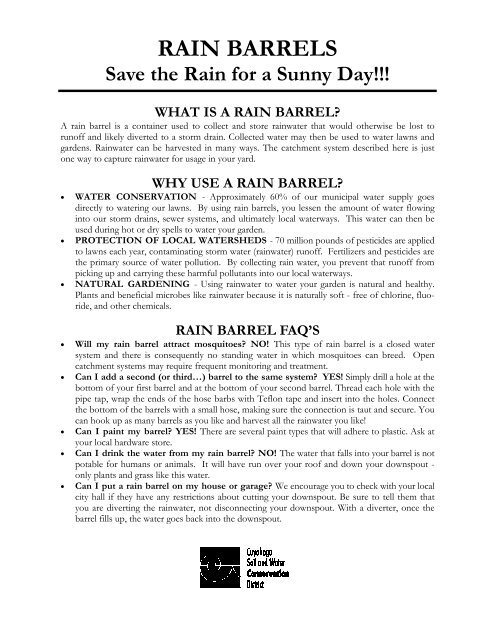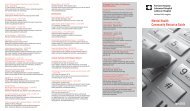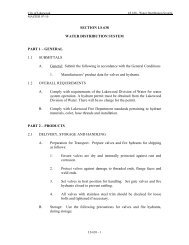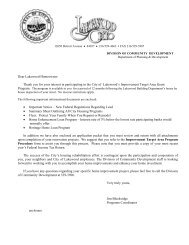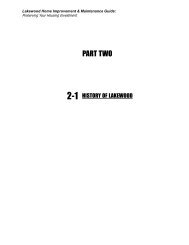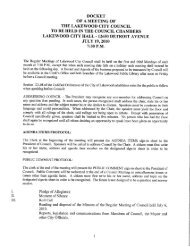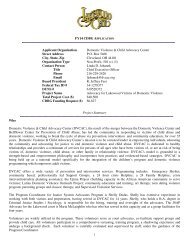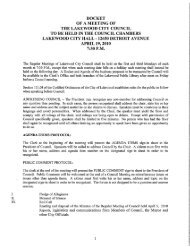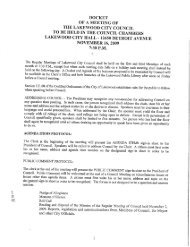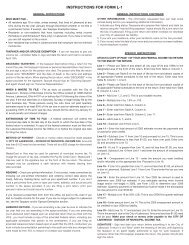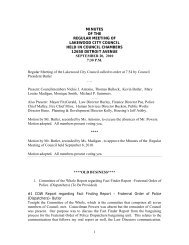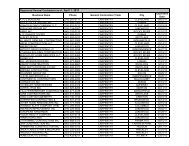Rain Barrel Information - City of Lakewood, Ohio
Rain Barrel Information - City of Lakewood, Ohio
Rain Barrel Information - City of Lakewood, Ohio
Create successful ePaper yourself
Turn your PDF publications into a flip-book with our unique Google optimized e-Paper software.
RAIN BARRELS<br />
Save the <strong>Rain</strong> for a Sunny Day!!!<br />
WHAT IS A RAIN BARREL<br />
A rain barrel is a container used to collect and store rainwater that would otherwise be lost to<br />
run<strong>of</strong>f and likely diverted to a storm drain. Collected water may then be used to water lawns and<br />
gardens. <strong>Rain</strong>water can be harvested in many ways. The catchment system described here is just<br />
one way to capture rainwater for usage in your yard.<br />
WHY USE A RAIN BARREL<br />
• WATER CONSERVATION - Approximately 60% <strong>of</strong> our municipal water supply goes<br />
directly to watering our lawns. By using rain barrels, you lessen the amount <strong>of</strong> water flowing<br />
into our storm drains, sewer systems, and ultimately local waterways. This water can then be<br />
used during hot or dry spells to water your garden.<br />
• PROTECTION OF LOCAL WATERSHEDS - 70 million pounds <strong>of</strong> pesticides are applied<br />
to lawns each year, contaminating storm water (rainwater) run<strong>of</strong>f. Fertilizers and pesticides are<br />
the primary source <strong>of</strong> water pollution. By collecting rain water, you prevent that run<strong>of</strong>f from<br />
picking up and carrying these harmful pollutants into our local waterways.<br />
• NATURAL GARDENING - Using rainwater to water your garden is natural and healthy.<br />
Plants and beneficial microbes like rainwater because it is naturally s<strong>of</strong>t - free <strong>of</strong> chlorine, fluoride,<br />
and other chemicals.<br />
RAIN BARREL FAQ’S<br />
• Will my rain barrel attract mosquitoes NO! This type <strong>of</strong> rain barrel is a closed water<br />
system and there is consequently no standing water in which mosquitoes can breed. Open<br />
catchment systems may require frequent monitoring and treatment.<br />
• Can I add a second (or third…) barrel to the same system YES! Simply drill a hole at the<br />
bottom <strong>of</strong> your first barrel and at the bottom <strong>of</strong> your second barrel. Thread each hole with the<br />
pipe tap, wrap the ends <strong>of</strong> the hose barbs with Teflon tape and insert into the holes. Connect<br />
the bottom <strong>of</strong> the barrels with a small hose, making sure the connection is taut and secure. You<br />
can hook up as many barrels as you like and harvest all the rainwater you like!<br />
• Can I paint my barrel YES! There are several paint types that will adhere to plastic. Ask at<br />
your local hardware store.<br />
• Can I drink the water from my rain barrel NO! The water that falls into your barrel is not<br />
potable for humans or animals. It will have run over your ro<strong>of</strong> and down your downspout -<br />
only plants and grass like this water.<br />
• Can I put a rain barrel on my house or garage We encourage you to check with your local<br />
city hall if they have any restrictions about cutting your downspout. Be sure to tell them that<br />
you are diverting the rainwater, not disconnecting your downspout. With a diverter, once the<br />
barrel fills up, the water goes back into the downspout.
HOW DO I MAKE AND INSTALL A RAIN BARREL<br />
You will need the following supplies. Keep in mind that you can always borrow a drill (and bit) and<br />
a pipe tap from a friend, as these items are expensive. <strong>Barrel</strong>s can be found at recycling centers<br />
or at container retailers. We get our barrels from Container Compliance 216/961-0035.<br />
They charge $20 for barrels and they power wash the barrels.<br />
Supplies:<br />
• 55 gallon barrel (make sure it is cleaned thoroughly)<br />
• 15/16” drill bit, and drill<br />
• ¾” pipe tap (these are about $25 and can be found at hardware stores - see if you can borrow<br />
one from someone instead <strong>of</strong> buying one, or come to a workshop, we have them there)<br />
• ¾” male spigot (boiler drain)<br />
• ¾” thread (male) to ½” hose connection hose barb<br />
• Teflon tape<br />
Instructions:<br />
With a 15/16” drill bit, drill one hole near the bottom <strong>of</strong> barrel for the spigot (boiler drain). Drill a<br />
second hole near the top <strong>of</strong> the barrel for the hose barb (keep in mind which side you want the<br />
hole on to connect to diverter from downspout)<br />
Thread both holes with ¾” pipe tap<br />
Wrap threaded ends <strong>of</strong> spigot and hose barb with Teflon tape and insert into appropriate holes<br />
You will need to elevate your rain barrel for several reasons. 1) the higher you put it, the better<br />
pressure you will get; 2) putting your rain barrel on stable ground and elevated will prevent it from<br />
sinking into the ground. A filled barrel will weigh over 400 lbs. Cinder blocks work well to elevate<br />
barrels.<br />
Downspout Diverter:<br />
There are several different diverters you can use to get the water from your downspout over to<br />
your barrel. The two that we have used are from www.gardenwatersaver.com or<br />
www.gardeners.com. Both will work fine.<br />
Maintenance:<br />
In the winter, be sure to empty out and store your rain barrel in a<br />
basement, garage, etc. If you don’t have a place to store it, you can leave it outside, just be sure to<br />
turn it upside down. If you use the diverter from www.gardeners.com, you will need to get a<br />
flexible downspout piece to connect the space on your downspout where the diverter was hooked<br />
up. These are inexpensive and can be found at any hardware store. If you use the diverter from<br />
www.gardenwatersaver.com, the diverter can stay on your downspout and be plugged with the plug<br />
provided.<br />
Please be sure to check out the Cuyahoga Soil and Water Conservation District website<br />
as they will be hosting several workshops across the county.<br />
www.cuyahogaswcd.org<br />
Encourage your neighbors and friends to install rain barrels! We are all a part <strong>of</strong> conservation!!<br />
Harvest <strong>Rain</strong>water!!


